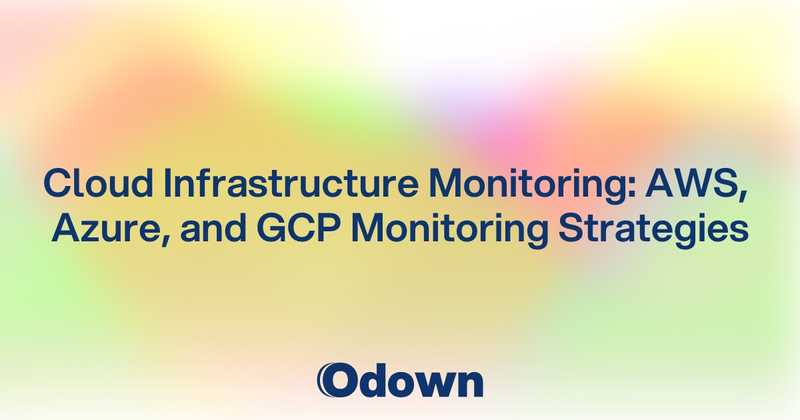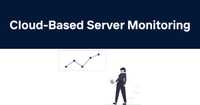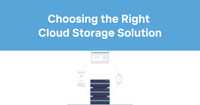Cloud Infrastructure Monitoring: AWS, Azure, and GCP Monitoring Strategies
Your cloud bill doubled last month, but you're not sure why. Your applications are randomly experiencing latency spikes that don't correlate with traffic patterns. You're paying for services you forgot you provisioned, and some of your instances are running at 5% utilization while others are constantly maxed out.
Welcome to cloud infrastructure monitoring in the real world. Unlike traditional on-premises environments where you know exactly what hardware you have and where it lives, cloud infrastructure is dynamic, distributed, and often invisible. Resources scale up and down automatically. Services span multiple availability zones. Your infrastructure changes faster than your documentation.
Effective cloud monitoring requires fundamentally different approaches than traditional infrastructure monitoring. You need visibility into ephemeral resources that might exist for minutes rather than years. You need to track costs alongside performance. And you need monitoring that works consistently across different cloud platforms as your architecture evolves.
Cloud-Native Monitoring: Tools and Services for Each Major Platform
Each major cloud provider offers comprehensive monitoring services designed specifically for their platform's unique characteristics and service ecosystem.
AWS CloudWatch and Advanced Monitoring
Amazon CloudWatch provides the foundation for AWS infrastructure monitoring with comprehensive metrics collection across all AWS services. Every EC2 instance, RDS database, Lambda function, and load balancer automatically publishes basic metrics to CloudWatch without requiring any configuration.
CloudWatch custom metrics allow you to track application-specific performance indicators alongside infrastructure metrics. This integration helps correlate business performance with infrastructure behavior and identify optimization opportunities that pure infrastructure monitoring might miss.
CloudWatch Logs centralizes log collection from all AWS services and EC2 instances, providing a unified place to search, filter, and analyze log data. Log insights enable complex queries across massive log volumes without requiring separate log management infrastructure.
CloudWatch Alarms provide sophisticated alerting capabilities that integrate with AWS SNS for notifications and AWS Auto Scaling for automated responses to performance issues. Composite alarms enable complex alerting logic that reduces false positives while ensuring critical issues get appropriate attention.
AWS X-Ray provides distributed tracing capabilities that track requests across AWS services including Lambda functions, API Gateway, ECS containers, and EC2 applications. This service-level tracing helps identify bottlenecks in complex serverless and microservices architectures.
Azure Monitor Ecosystem
Azure Monitor consolidates metrics, logs, and traces from all Azure services into a unified monitoring platform. The service automatically collects platform metrics from Azure resources while providing extensive customization options for application-specific monitoring needs.
Azure Application Insights offers comprehensive APM capabilities that integrate seamlessly with Azure services. The service provides code-level visibility into applications running on Azure App Service, Azure Functions, and Azure Container Instances.
Azure Log Analytics provides powerful query capabilities across all Azure Monitor data using Kusto Query Language (KQL). This query interface enables complex analysis that correlates infrastructure performance with application behavior and business outcomes.
Azure Sentinel extends monitoring into security analytics by analyzing Azure Monitor data for threat detection and incident response. This integration provides security monitoring that leverages existing infrastructure monitoring data rather than requiring separate security information collection.
Azure Cost Management integrates with Azure Monitor to provide cost visibility alongside performance metrics. This integration helps identify cost optimization opportunities by correlating resource utilization with spending patterns.
Google Cloud Operations Suite
Google Cloud Operations (formerly Stackdriver) provides monitoring, logging, and debugging capabilities designed specifically for Google Cloud Platform services and architectures.
Cloud Monitoring automatically collects metrics from all GCP services while providing extensive custom metrics capabilities for application monitoring. The service includes intelligent alerting that uses machine learning to reduce false positives and improve signal-to-noise ratios.
Cloud Logging centralizes log collection across GCP services with advanced filtering, searching, and analysis capabilities. Log-based metrics enable custom monitoring based on log content patterns without requiring separate metric collection infrastructure.
Cloud Trace provides distributed tracing for applications running on GCP including App Engine, Cloud Functions, and GKE clusters. The service automatically instruments popular frameworks while providing APIs for custom trace generation.
Cloud Profiler helps identify performance bottlenecks in applications running on GCP by providing statistical profiling data with minimal performance overhead. This service reveals optimization opportunities that might not be obvious from traditional monitoring metrics.
Error Reporting automatically aggregates and categorizes application errors from GCP services, providing visibility into error patterns and trends that help prioritize debugging efforts.
Multi-Cloud Monitoring: Unified Visibility Across Cloud Providers
Organizations increasingly use multiple cloud providers for different workloads, requiring monitoring strategies that provide consistent visibility across heterogeneous cloud environments.
Cross-Platform Monitoring Challenges
Different cloud providers use different metric formats, collection intervals, and service naming conventions. This inconsistency makes it difficult to create unified dashboards and alerting policies that work consistently across platforms.
Cloud provider APIs often have different rate limits, authentication methods, and data access patterns. Monitoring tools need to handle these differences while providing consistent user experiences regardless of underlying cloud platform complexity.
Service mapping across cloud providers requires translation layers that correlate similar services with different names and capabilities. AWS RDS, Azure SQL Database, and Google Cloud SQL provide similar functionality but expose different metrics and management interfaces.
Network connectivity and security policies often differ between cloud providers, affecting how monitoring tools collect data and where monitoring infrastructure can be deployed. Some monitoring approaches that work well within a single cloud provider become complex when spanning multiple providers.
Unified Monitoring Platform Strategies
Third-party monitoring platforms like Datadog, New Relic, and Splunk provide cloud-agnostic monitoring that works consistently across AWS, Azure, and GCP. These platforms handle cloud provider differences while presenting unified interfaces for monitoring and alerting.
Open-source monitoring stacks using Prometheus, Grafana, and related tools can provide cost-effective multi-cloud monitoring with complete control over data retention and processing. These solutions require more operational overhead but offer maximum flexibility and customization.
Cloud provider monitoring APIs enable custom monitoring solutions that aggregate data from multiple clouds into unified dashboards and alerting systems. This approach provides complete control but requires significant development and maintenance effort.
Standardized monitoring agents deployed across all cloud environments can provide consistent metric collection regardless of underlying cloud platform. Tools like Telegraf, Fluentd, and OpenTelemetry collectors work consistently across different cloud providers.
Data Correlation and Analysis
Correlate performance and cost data across multiple cloud providers to identify optimization opportunities and architectural improvements. Some workloads might perform better or cost less on different cloud platforms.
Implement tagging strategies that work consistently across cloud providers to enable meaningful resource grouping and cost allocation. Consistent tagging enables analysis by business unit, project, environment, or application regardless of where resources are deployed.
Use time synchronization and common metric naming conventions to enable meaningful comparison and analysis across cloud platforms. Inconsistent timestamps or metric definitions make cross-cloud analysis difficult or impossible.
Build dashboards that normalize differences between cloud providers while highlighting platform-specific optimization opportunities. Users should be able to understand overall system health without needing to understand the nuances of each cloud platform.
Cloud Cost Optimization Through Performance Monitoring
Cloud infrastructure costs often correlate poorly with actual resource utilization, creating opportunities for significant savings through performance-driven optimization.
Resource Utilization Analysis
Track CPU, memory, and storage utilization patterns to identify over-provisioned resources that could be downsized without affecting performance. Many cloud instances run at low utilization because teams over-provision to avoid performance problems.
Analyze utilization patterns over time to understand peak usage requirements versus average consumption. Resources that spike occasionally might benefit from auto-scaling rather than constant over-provisioning.
Identify completely unused resources that continue generating costs without providing any business value. Orphaned instances, unattached storage volumes, and forgotten development environments often account for significant unnecessary spending.
Compare utilization patterns with cloud provider pricing models to identify opportunities for reserved instance purchases, spot instance usage, or alternative service configurations that provide better cost efficiency.
Auto-Scaling Optimization
Monitor auto-scaling behavior to ensure scaling policies match actual performance requirements rather than over-conservative defaults. Many auto-scaling configurations scale up aggressively but scale down slowly, leading to unnecessary costs.
Analyze scaling triggers and thresholds to optimize responsiveness while minimizing costs. Scaling based on multiple metrics often provides better results than simple CPU-based scaling that might not reflect actual application performance needs.
Track the cost impact of auto-scaling decisions to understand whether scaling policies are cost-effective. Some workloads might benefit from accepting occasional performance degradation rather than paying for constant over-provisioning.
Consider predictive scaling based on historical patterns rather than purely reactive scaling. Applications with predictable traffic patterns can scale proactively to improve performance while optimizing costs.
Service Selection and Optimization
Use performance monitoring data to evaluate whether current cloud service selections are optimal for actual workload requirements. Managed services might provide better cost efficiency than self-managed alternatives for some workloads.
Analyze database performance and utilization to optimize instance types, storage configurations, and backup policies. Database costs often represent significant portions of cloud spending and provide substantial optimization opportunities.
Evaluate serverless versus container versus virtual machine trade-offs based on actual usage patterns rather than theoretical requirements. Performance monitoring reveals which platforms provide the best cost-performance ratio for specific workloads.
Monitor data transfer costs and patterns to optimize content delivery, caching, and data storage strategies. Data transfer charges can become significant for high-traffic applications and often provide optimization opportunities.
Cost Anomaly Detection
Implement cost monitoring alerts that detect unusual spending patterns that might indicate performance problems, security issues, or configuration mistakes. Sudden cost increases often correlate with technical problems that need immediate attention.
Correlate cost increases with performance changes to identify whether additional spending actually improves user experience or business outcomes. Not all cost increases represent problems if they correlate with business growth or performance improvements.
Track cost trends over time to predict future spending and identify gradual cost increases that might indicate architectural problems or inefficient resource usage patterns.
Use cost forecasting based on performance trends to plan capacity and budget for business growth while identifying optimization opportunities that can offset increased usage costs.
Security Monitoring in Cloud Environments: Threats and Detection
Cloud security monitoring requires different approaches than traditional on-premises security because of shared responsibility models, dynamic infrastructure, and cloud-specific attack vectors.
Cloud-Specific Security Threats
Identity and access management (IAM) misconfigurations create security vulnerabilities unique to cloud environments. Over-privileged service accounts, misconfigured role assignments, and insecure credential management practices often create attack vectors that don't exist in traditional environments.
Data exposure through misconfigured storage services represents a significant cloud security risk. Public S3 buckets, unencrypted databases, and insecure API endpoints can expose sensitive data through configuration mistakes rather than sophisticated attacks.
Resource hijacking attacks target cloud accounts to use computational resources for cryptocurrency mining, spam distribution, or other malicious activities. These attacks often manifest as unusual cost increases and performance degradation.
Insider threats in cloud environments can be more difficult to detect because of the dynamic nature of cloud resources and the complexity of access logging across multiple services and platforms.
Security Monitoring Integration
Integrate security monitoring with performance monitoring to identify security incidents that might manifest as performance anomalies. DDoS attacks, resource hijacking, and data exfiltration often create detectable performance signatures.
Use cloud provider security services like AWS GuardDuty, Azure Sentinel, and Google Security Command Center to detect threats specific to each cloud platform. These services leverage cloud provider threat intelligence and behavioral analysis.
Implement log aggregation and analysis that correlates security events across multiple cloud services and regions. Sophisticated attacks often span multiple cloud services and geographic regions to avoid detection.
Monitor network traffic patterns for anomalies that might indicate data exfiltration, command and control communications, or lateral movement within cloud infrastructure.
Compliance and Audit Requirements
Implement monitoring that supports compliance requirements for regulations like GDPR, HIPAA, PCI DSS, and SOX. Cloud compliance often requires continuous monitoring and automated reporting rather than periodic audits.
Track configuration changes and access patterns to demonstrate compliance with security frameworks and audit requirements. Many compliance frameworks require detailed logging of administrative actions and data access patterns.
Use immutable log storage and retention policies that meet regulatory requirements while supporting security investigation needs. Cloud storage services often provide compliance-ready logging and retention capabilities.
Implement automated compliance checking that continuously validates cloud configurations against security baselines and regulatory requirements. Manual compliance checking doesn't scale to dynamic cloud environments.
Incident Response and Forensics
Prepare incident response procedures that account for cloud-specific challenges like ephemeral resources, shared infrastructure, and multi-region deployments. Traditional incident response procedures often need adaptation for cloud environments.
Implement automated response capabilities that can isolate compromised resources, preserve forensic evidence, and maintain service availability during security incidents. Cloud APIs enable sophisticated automated response capabilities.
Develop forensic capabilities that work with cloud provider logging and monitoring services. Cloud forensics often requires different tools and techniques than traditional on-premises investigations.
Plan for coordinating incident response across multiple cloud providers when security incidents span multi-cloud environments. Each cloud provider has different incident response capabilities and procedures.
Cloud infrastructure monitoring transforms from a nice-to-have capability into a business necessity as organizations rely increasingly on cloud services for mission-critical applications. Effective monitoring provides the visibility needed to optimize costs, maintain security, and ensure reliable performance across complex cloud architectures.
The investment in comprehensive cloud monitoring pays dividends in reduced costs, improved security posture, and better application performance. You finally get control over cloud environments that would otherwise remain opaque and difficult to optimize.
Ready to master cloud infrastructure monitoring? Odown provides comprehensive cloud monitoring that works across AWS, Azure, and GCP with unified dashboards and intelligent alerting. Combined with our Application Performance Monitoring guide, you'll have complete visibility into both infrastructure performance and application behavior across all your cloud environments.



